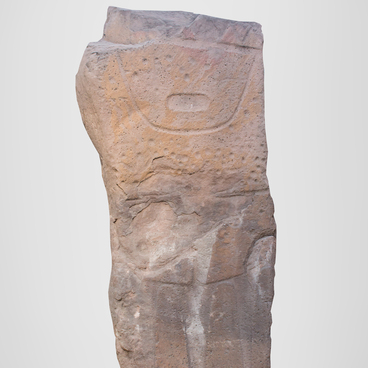The stone statue “Khys tas” was located 300 meters north-east of Mount Khizil Khas in the Shirinsky region of the Republic of Khakassia. Archaeologists discovered it at the end of the 19th century, and a century later the archaeologist Albert Lipsky took it to the Khakass Museum of Local History.
In Khakass “Khys tas” means a “stone girl”. The statue was carved from a slab of red sandstone. A face with human and animal features is carved on the narrow edge of the monument. The researchers came to the conclusion that the sculpture in the place of the image of the face and chest of the deity was being finalized after its creation.
The weight of the boulders, from which the ancient craftsmen carved such statues, reached several tons. Bronze tools were not suitable for stone processing, since bronze is too soft a material, therefore, future monuments were most likely worked on using stone chisels.
On the oval face “khys tas” with a narrow chin, small circles with dots inside indicate the eyes, two dots schematically depict the nostrils. In the center, a long, widening nose is carved from the bottom; a mouth is outlined below with a curved strip. Another round dot can be seen on the bridge of the nose — the researchers suggest that in this way the master depicted the third eye of the deity.
In the upper part of the face, stylized images of ears and, presumably, horns are carved. In the middle part, a vertical headdress is depicted, which is a tall and narrow rectangle with complex elements of decor and ornaments. At the bottom, it is divided into two rectangles, inside which images of oblique crosses are engraved.
Below, on the plane of the stone, the chest of the deity is marked in two half-arcs, and it is in this part that the stone has traces of additional relief processing. The statue dates back to the Okunev archaeological culture. Its representatives were the tribes of cattle breeders of the Bronze Age. Research suggests that the main activity of the Okunevites was sheep and cattle breeding, but at the same time metallurgy was also developed. They used not only copper, but also bronze; they engaged in forging and casting.
In Khakass “Khys tas” means a “stone girl”. The statue was carved from a slab of red sandstone. A face with human and animal features is carved on the narrow edge of the monument. The researchers came to the conclusion that the sculpture in the place of the image of the face and chest of the deity was being finalized after its creation.
The weight of the boulders, from which the ancient craftsmen carved such statues, reached several tons. Bronze tools were not suitable for stone processing, since bronze is too soft a material, therefore, future monuments were most likely worked on using stone chisels.
On the oval face “khys tas” with a narrow chin, small circles with dots inside indicate the eyes, two dots schematically depict the nostrils. In the center, a long, widening nose is carved from the bottom; a mouth is outlined below with a curved strip. Another round dot can be seen on the bridge of the nose — the researchers suggest that in this way the master depicted the third eye of the deity.
In the upper part of the face, stylized images of ears and, presumably, horns are carved. In the middle part, a vertical headdress is depicted, which is a tall and narrow rectangle with complex elements of decor and ornaments. At the bottom, it is divided into two rectangles, inside which images of oblique crosses are engraved.
Below, on the plane of the stone, the chest of the deity is marked in two half-arcs, and it is in this part that the stone has traces of additional relief processing. The statue dates back to the Okunev archaeological culture. Its representatives were the tribes of cattle breeders of the Bronze Age. Research suggests that the main activity of the Okunevites was sheep and cattle breeding, but at the same time metallurgy was also developed. They used not only copper, but also bronze; they engaged in forging and casting.



